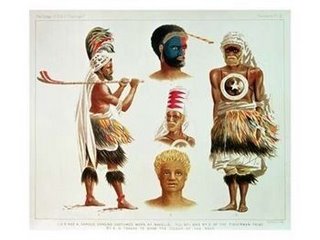



from w.
Many drawings and photos of Fijian men from the mid 19th century can be found on the websites of Rod Ewins and Jane Resture. I will put a few other pics here to show the change in dress, such as Fijian chiefs’ costume as in some Fiji stamps from a lovely website of Fijian stamps From the malo - brief masi wrap of the warrior to being clad in masi - barkcloth to the modern day bula shirt and sulu.
Matching shirts and sulus are popular for special occasions and the term used is 'colourvata' - same colour.


2 comments:
Bula shirts and sulus are cool. Literally. Cotton is an excellent fabric for the tropics - and forget wearing a tie.
In Hawaii, the only people who wear ties are bankers and lawyers. Makes them easy to identify and avoid in public. ;^)
i was also gonna say something about hawaii. their colored clothing reminds me a lot of hawaii and the ppl there. very similar.
Post a Comment